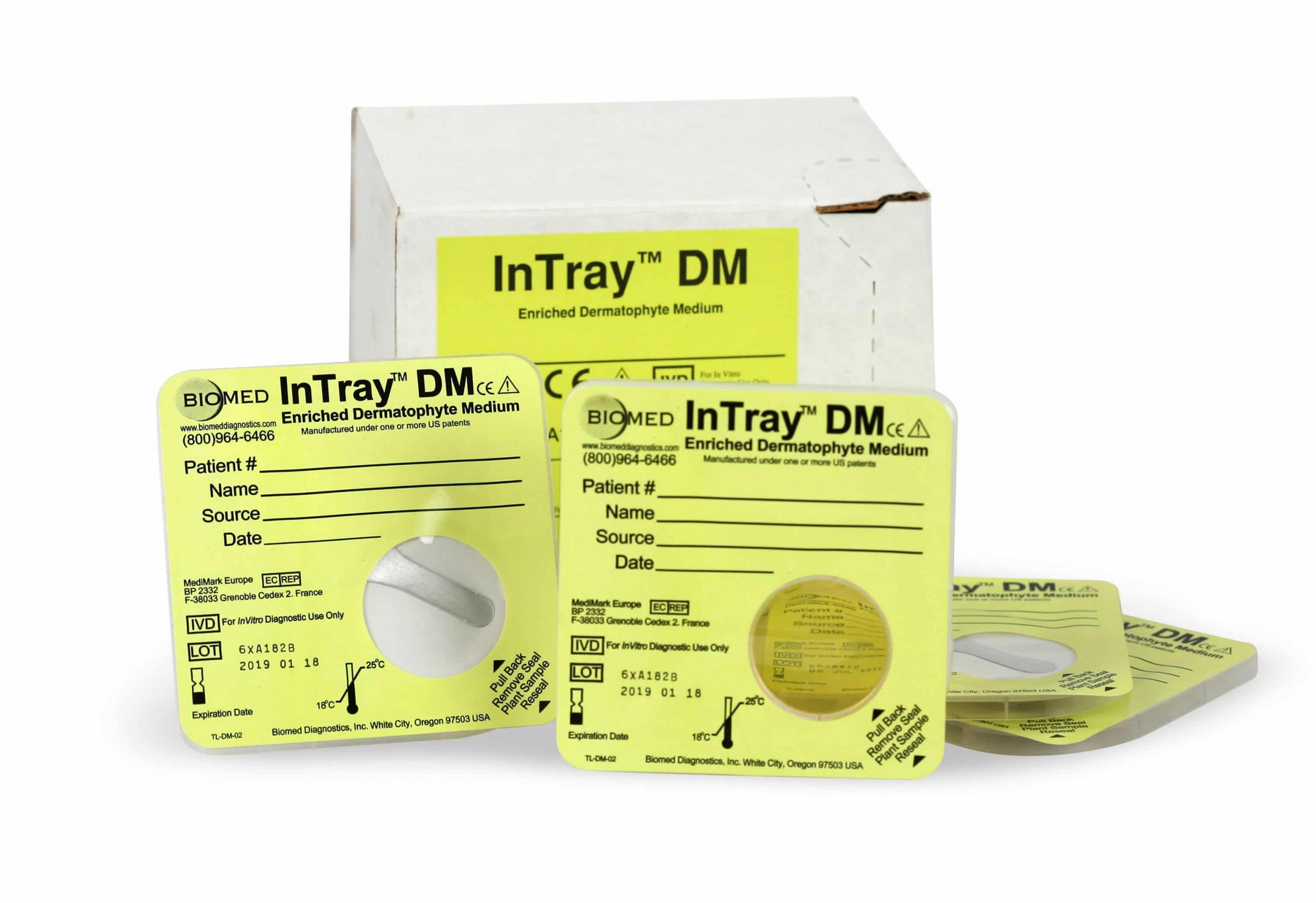INTRAY DM DIAGNOSTIC TEST KIT
The InTray DM system consists of an outer, re-sealable label with an optically clear, anti-fog window covering the media creating an airtight seal over the 1″ diameter surface.
The innovative design of the InTray, with its unique, high-performance viewing window, can be placed directly under a microscope, while remaining sealed.
The InTray removes the need to prepare slides or expose the sample once the device has been inoculated. By combining both growth and observation into one fully enclosed system, the InTray DM removes the need for multiple procedures, increases throughput and decreases the cost of laboratory materials and medical waste.


Product Features & Benefits:
- Easy to use – pull back the label, remove and discard seal, plant sample and reseal label.
- Evaluation – Microscopically observe the medium for growth and colour change without opening the InTray DM.
- The InTray DM is formulated to produce a red colour in the presence of growing dermatophytes.
- Accepts hair, nail or skin samples
- Easy-to-use tray simply pull back the label, remove and discard seal, plant sample and reseal label
- Undisturbed dermatophyte growth enhances identification of specific dermatophytes when placing the InTray on the microscope stage
- Uses the innovative InTray packaging system, which combines inoculation, transportation, growth and observation in a single tray
- Specially-formulated, enriched medium produces distinctive morphology and increases specificity by inhibiting both gram-positive and gram-negative bacteria
FAQ’S
The system is designed to culture hair, skin or nail samples. Hair samples should be grasped at the uninfected end and several small pieces should be cut from the infected portion for inoculation onto the surface of the medium. Nail samples should be cut into several small pieces for best results.
Based on observations, 100x magnification is used to determine general growth characteristics without opening the tray window. Clarification of the micro and macroconidia should use a higher power such as 200x magnification.?Be sure to focus up and down through the medium. Some organisms will grow on top of and through the medium. The colony growth will exhibit characteristic color and structures (See InTray Dermatophyte Identification Chart).
Color change can be observed as early as 24 hours. This is highly dependent upon the species and the sample. Observe the tray for a color change for 10 days before discarding it. Colony growth must also be observed.
Bacteria are inhibited from growing. Some saprophytic fungi grow on the medium and they will produce a red color change. However the colonies are darker in color (brown, green or black). Aspergillus and Penicillium are the most common
Most Candida species are inhibited except Candida albicans. C. albicans will cause a rapid (24-48 hours) color change. Other yeast species take 7 or more days to grow. Prolonged growth will change the color slowly to red. However, the appearance of yeast colonies is pasty, waxy or shiny (glass-like) unlike the cottony or granular dermatophyte growth. Yeast and saprophytic fungi can be pathogenic depending upon the patient’s general health and medications.
This is probably due to soap residue. Always clean the affected area thoroughly with 70% alcohol and air dry before obtaining the sample. The colour change is usually temporary.
This could be due to:
- It is a yeast that is trying to grow but is being inhibited. Under microscopic examination, yeast can appear as clusters of small bubbles. Subculturing onto a Colorex Yeast tray will help to identify the yeast.
- A Dermatophyte and/or a saprophyte it is being inhibited. Be sure to check that you have not covered the air filter hole on the back of the tray. The organisms will take longer to grow (even go dormant) if they do not have adequate air. Do not place the inoculated tray in a 37 C incubator. Do not place the tray in direct sunlight.
There are probably two or more organisms trying to grow. They are competing for the same nutrients and as a result colony morphology can appear different. If the growth is too heavy to examine microscopically, we recommend that you send the unopened tray to a reference lab for subculturing and identification.
We like to say at wine cellar temperature, that is 15 C to 25 C (55F to 77F). Un-inoculated kits can remain in the box until use. Before use, please examine each tray. The media should be a clear yellow color. Any other color, cloudiness, and crystals are unacceptable. The medium should not be dry or have large bubbles. All seals should be intact.
DO NOT FREEZE OR HEAT OVER 40 C (104 F)!
The InTray TM DM can be vertically incubated.
After inoculation, the InTray TM DM can be stored in a vertical position to allow for the run-off of any condensation that may occur during colony growth. The tray lid is specifically designed to allow for the clearing of condensation for optimal viewing of the organisms. A small clear plastic storage box (no lid) or a 3x 8 test tube drying rack are good incubators.
Biomed Diagnostics, Inc. routinely performs QC tests on each lot of each product throughout its shelf life. We will notify distributors and customers if we find any abnormalities and if we find additional uses for our products.
We recommend that customers perform a Quality Control test if they suspect that the InTray DM has been exposed to temperatures outside the guidelines.
Please notify your distributor and Biomed Diagnostics, Inc. if your InTray DM fails your QC testing.
InTray DM has an expiration date of 24 months from the date of manufacture. You should routinely receive product with greater than 6 months dating.
